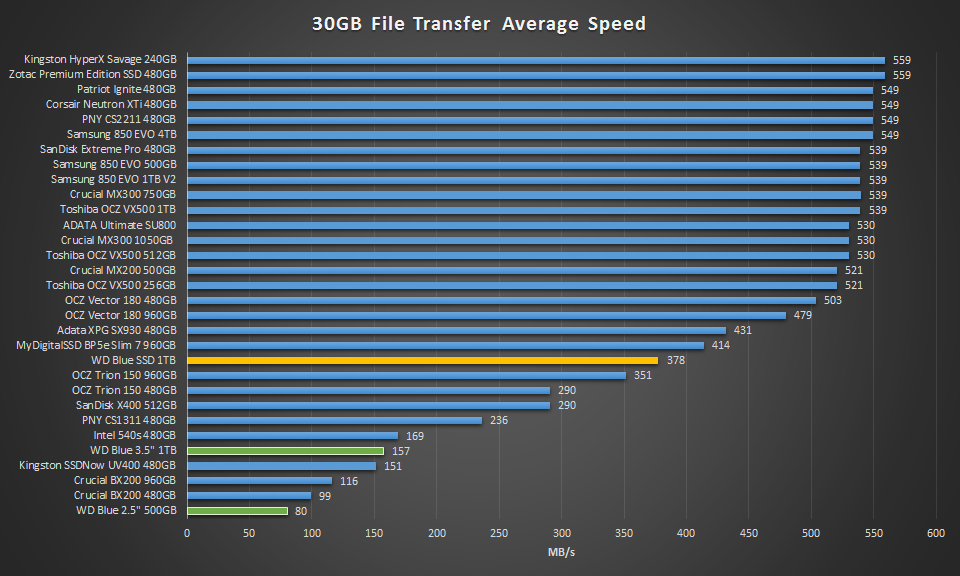REAL WORLD FILE TRANSFER
We also wanted to see how performance was in a real world use when transferring large files to the SSD. For this test we are going to simply stress write performance by transferring over a 30GB folder of movies off of a 512GB Samsung 950 Pro to the test SSDs and time how long it takes. Once complete we can calculate the average speed. For reference we have included both a 2.5″ and 3.5″ WD Blue HDD.
During this test the WD Blue obviously performs much better than its HDD brethren. It averaged 378MB/s when writing the movies to it. This performance is a bit better than most of the TLC SSDs out there except for the 3D powered MX300, Samsung 850 EVO, and surprisingly, the planar MyDigitalSSD BP5e Slim.
POWER CONSUMPTION
For our power consumption testing, we have the drive connected to the system as a secondary drive. To record the wattage, we are now utilizing a Quarch Technology Programmable Power Module. It allows us to accurately measure power consumption over time and is flexible enough to allow us to test any SSD that comes our way.
Our power analysis may change as time goes on, but for now we are looking at just a few metrics with the main goal of measuring our results against the manufacturer’s ratings. Because most consumer systems are at idle for about 80% of the time, idle power consumption is an important measure to look at when understanding the efficiency of a drive.
Looking at the drive’s idle power consumption, its result is very good. The WD Blue SSD only consumes 53mW at idle, which is in line with its rating.
POWER EFFICIENCY
Finally, we wanted to post up a graph of the power efficiency of the SSDs in comparison. We are looking at MB/s per Watt in this graph. The higher the result, the better.
In the chart above we can see that SSDs can be magnitudes more efficient than standard HDDs. Overall, the WD Blue places in the mid-section of our comparison chart. The TLC powered SSDs typically don’t do well in this metric unless they utilize 3D NAND. This result, however, looks to be the highest efficiency result we have seen from a planar TLC SSD.
 The SSD Review The Worlds Dedicated SSD Education and Review Resource |
The SSD Review The Worlds Dedicated SSD Education and Review Resource | 


Been so quiet thought you’d all gone on holiday together.
WD will need to learn the SSD pricing game really quick.
Wonderful to see someone else reaching 10K-4K iops.
thro in other reviews it’s all over the place-Crystal 10K+
AS-SSD 7K7 and Anvil 7K9………………………….
Be interesting to see how smaller drives go…………….
EDIT
as to your surprise how well this drive performed fol planer TLC.
Thro Sammy were first out the door-we all know the problems
the 840 series had.And Crucial’s BX200 sits just above the lemons.
Sandisk produced a good midrange drive with the Ultra2 quite a while ago.
c’mon, 2d tlc needs to die quick. 3d tlc can’t come soon enough for budget drives.
I came across this file transfer tool called Binfer. I have used Binfer to transfer large files with Binfer several times and recommend it highly. It does require the senders computer to stay online.